Affiliate disclosure: This post may contain affiliate links. Please see our Privacy Policy.
Bugleweed (Ajuga sp.) is a family of wild edible weeds that grow all over the world, and they make a tasty addition to salads. Though often considered a weed, it’s quite beautiful, and grows in dense purple/green carpets, dotted with tiny purple flowers.
Ajuga species been used medicinally for centuries, and they’re showing promise in modern studies for regulating hormone levels, especially in women. It’s also used topically to stop bleeding and treat wounds.
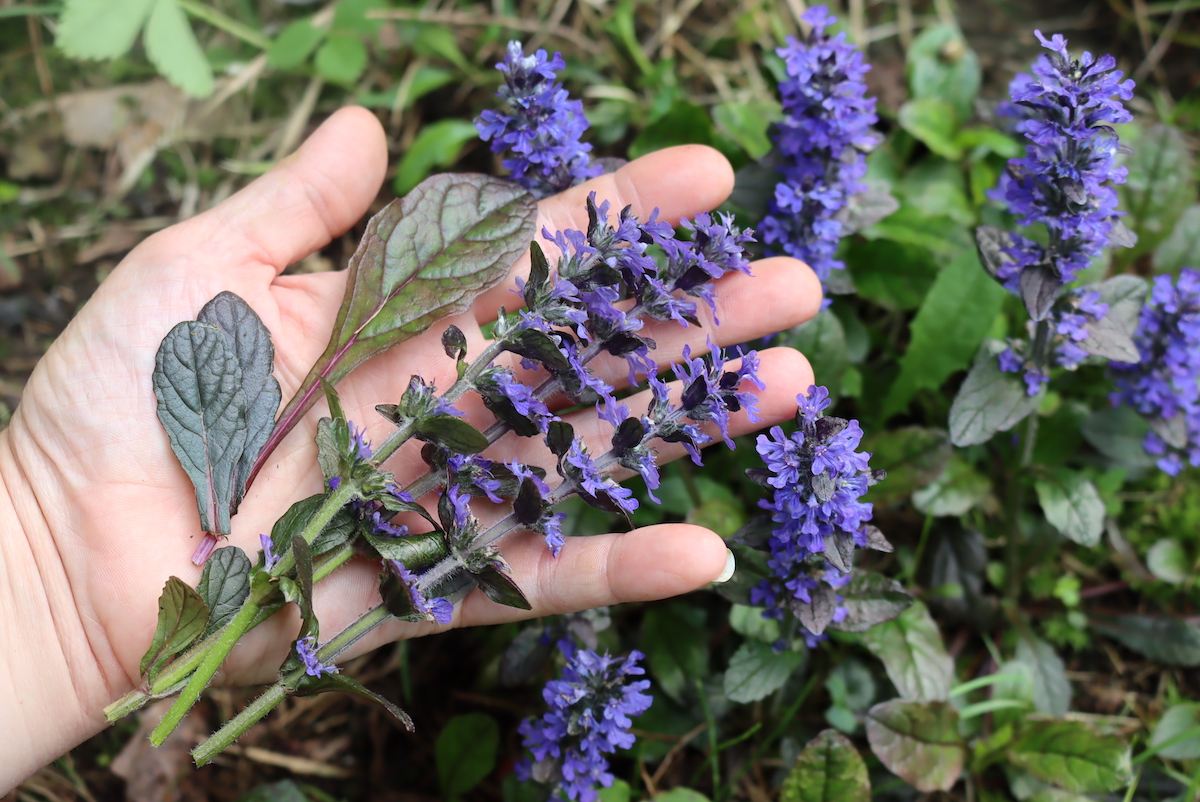
This past year, I made a goal to identify as many wild lawn weeds as possible. I scoured soccer fields, pastures, sidewalk edges, parks and more…but in the end, I found the most species within 50 feet of my house.
Bugleweed was one of the first new wild weeds I found, simply because it’s so easy to spot. The dark purple leaves stand out against a low growing green background.
While tiny, the purple flowers are strikingly beautiful too.
With a little research, I learned I had found Bugleweed, a common edible lawn weed in the mint family that’s been used medicinally for centuries.
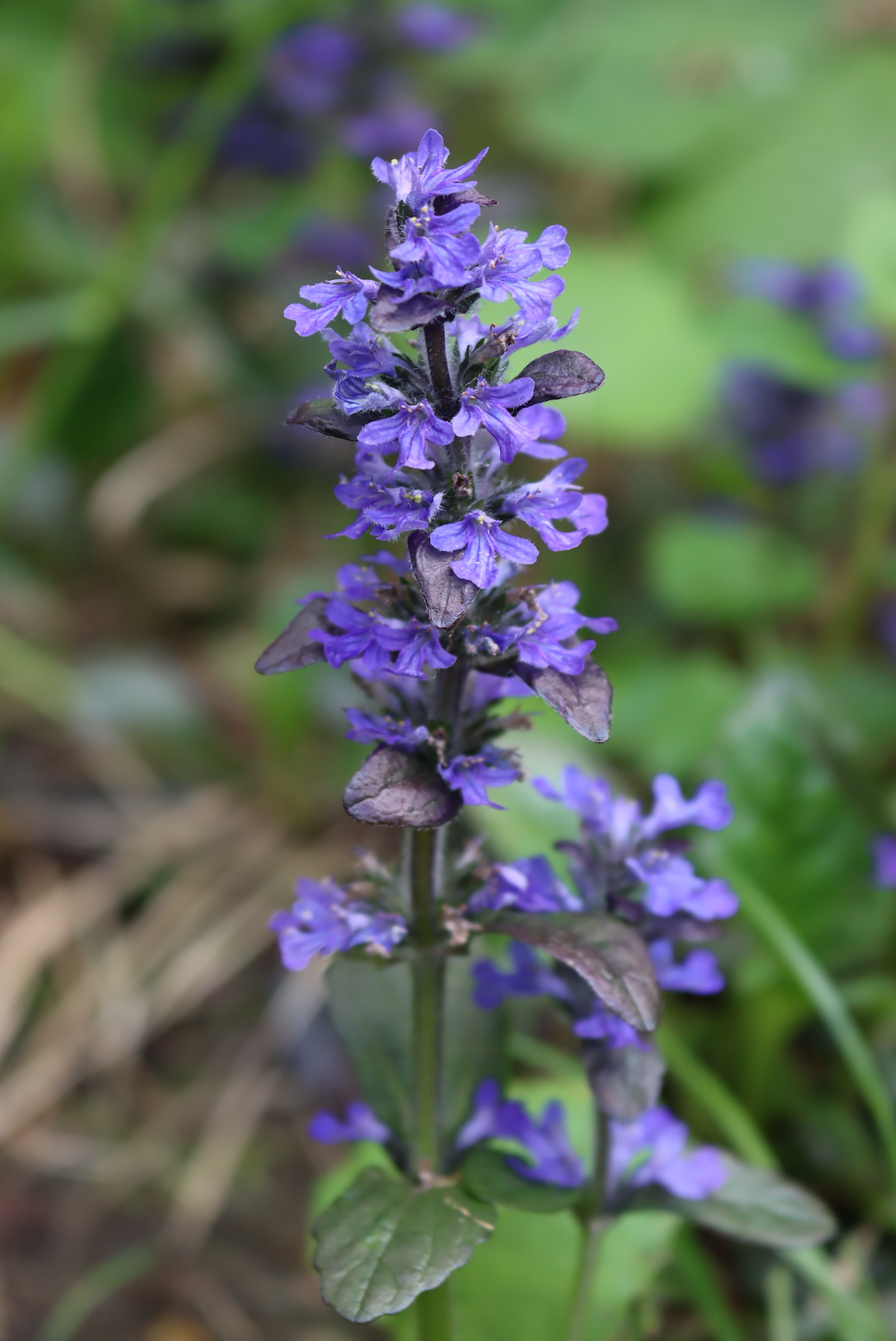
What is Bugleweed?
Bugleweed is a herbaceous perennial that is native to Europe and is invasive in certain parts of North America.
It’s a member of the mint or Lamiaceae family and is known by many common names, including Bugle, Blue Bugle, Sweet Bugle, Common Bugle, Carpet Bugleweed, Carpetweed, Carpenter’s Herb, gypsy Weed, Gypsywort, Wolf’s Mint (Menta de Lobo), Green Wolf’s Foot and occasionally the St. Lawrence Plant.
It should not be confused with American Bugleweed (Lycopus Americanus), a perennial plant native to the United States.
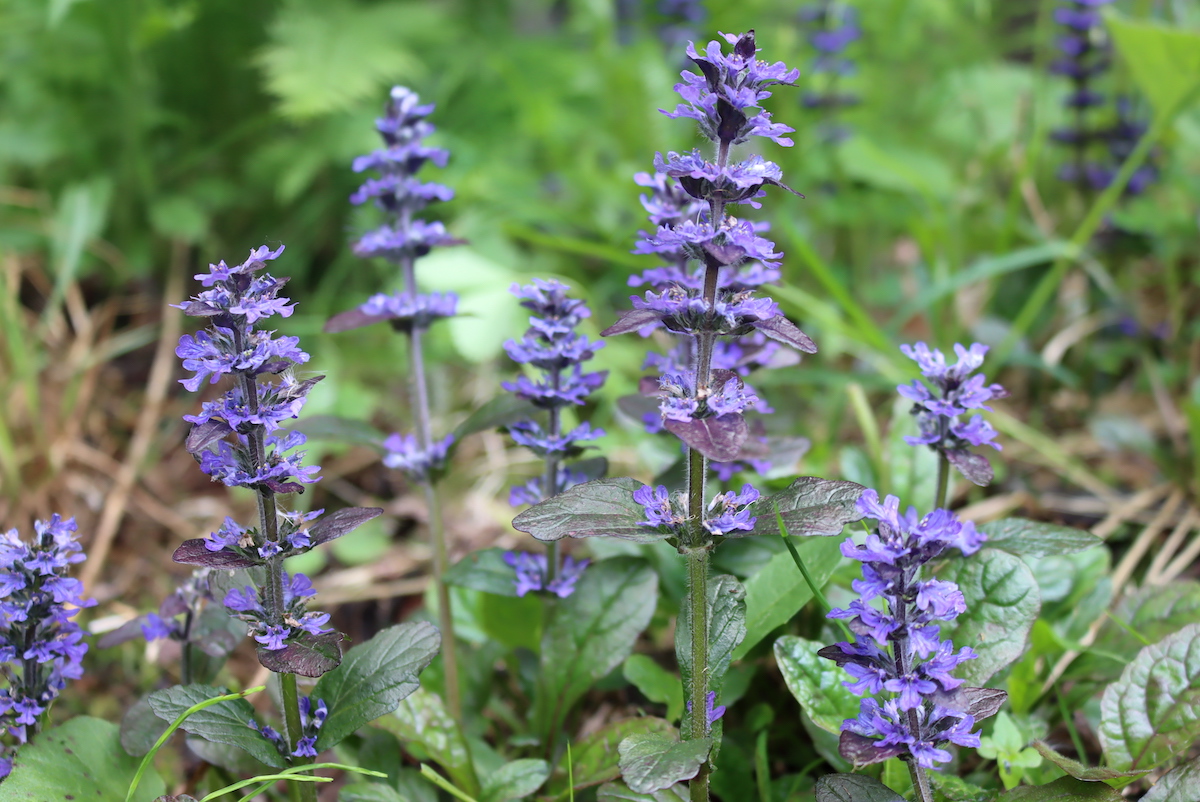
Is Bugleweed Edible?
Yes, Bugleweed is edible. The young shoots and leaves can be eaten raw or cooked.
Older leaves tend to become too bitter to eat raw, but you can still use them sparingly for cooked dishes. The flowers may be eaten raw or added to tea with other parts of the plant. Bugleweed also has a long history in herbal medicine and can be dried for later use.
Use caution when consuming Bugleweed. Bugleweed may interact with diabetes and heart medications. Anyone who is pregnant or nursing should talk to a physician before consuming Bugleweed, as it can impact the thyroid and lactation hormones (which is how it’s often used medicinally).
When harvesting Bugleweed, avoid areas that may have been sprayed with pesticides or other chemicals.
Bugleweed Medicinal Benefits
Historically, Bugleweed has been used in herbal medicine practices across its native range.
In modern herbal medicine, Bugleweed is most often used to treat hormonal issues, namely hyperthyroidism. It also reduces prolactin, a female hormone, and for that reason it’s used to treat breast pain, heavy menstrual bleeding and other PMS symptoms.
It’s also been shown to help with nervousness and anxiety associated with menstrual cycles and hormonal shifts.
Bugleweed is an important part of Austrian herbal medicine. It was used internally, typically as a tea, for its anti-inflammatory properties to treat respiratory tract ailments. A modern study has corroborated these claims, finding that the herb has anti-inflammatory and antioxidant properties, which appeared to speed wound healing.
In Pakistan, researchers found that Bugleweed is often employed to treat diabetes, jaundice, malarial fever, colic, epilepsy, sore throat, abdominal pain, and dental issues.
The tea has also been used to treat mouth ulcers and sore throats and as a hangover cure or heart tonic. As a heart tonic, herbalists believe Bugleweed may have similar properties to digitalis though they are thought to be milder.
Externally, herbalists have used it to stem minor bleeding and heal bruises earning it the name Carpenter’s Weed.
Bugleweed was often applied fresh as a poultice or the whole plant was dried and saved for later use in herbal oils and ointments. Nicholas Culpeper, a well-known 17th century English herbalist, regarded it highly used as an ointment or plaster for wounds.
Where to Find Bugleweed
Bugleweed is native to Europe, northern Africa, and Asia. In North America, you can find this invasive plant across most of the eastern, midwestern, and northwestern states. It also grows in parts of eastern and western Canada.
You’re most likely to spot Bugleweed in waste places, rough pastures, and forest edges. You can also find it around old gardens where it has escaped cultivation.
Bugleweed primarily grows in areas with full shade to partial sun but will tolerate full sun. It may grow more slowly in full sun, and the foliage’s appearance can change depending on light conditions.
Bugleweed thrives in areas with humusy, well-drained soils with good moisture. It will tolerate moderately dry soils but is susceptible to crown rot in heavy, wet clay soils.
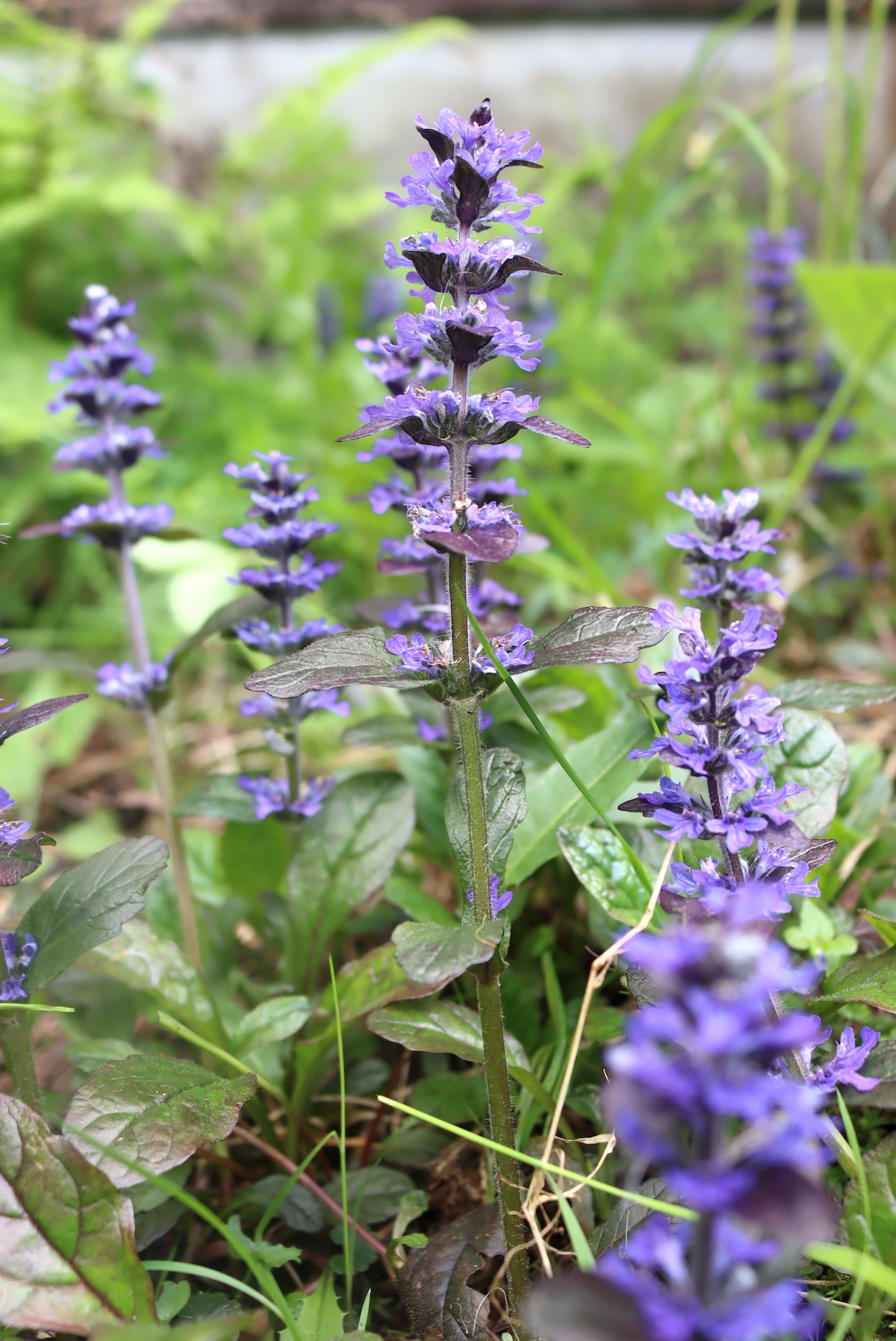
When Does Bugleweed Grow?
Bugleweed is evergreen, so you can find it year-round in warm climates. Bugleweed may be only semi-evergreen in cold climates and can die back some in the winter but returns in early spring.
It’s easiest to identify when it’s in flower from early May to mid-June depending on your location. The flower stalks die back in late summer or fall, so the rest of the year, all you’ll find is the basal rosette of leaves.
Identifying Bugleweed
Bugleweed is evergreen or semi-evergreen and has a sprawling nature. It sends out stolons that root at their nodes producing new plants. In this way, it creates a dense, fast-spreading ground cover. This feature has given Bugleweed the common names Carpet Bugleweed and Carpetweed.
You can identify Bugleweed by the carpet of rosettes of shiny leaves, but it’s easiest to recognize in spring when it’s in flower. In spring, dense patches of Bugleweed put out flower spikes four to fourteen inches tall. These spikes are whorled blue-violet flowers creating a striking display.
Its beautiful flowers and ability to block weeds made it a popular garden ground cover.
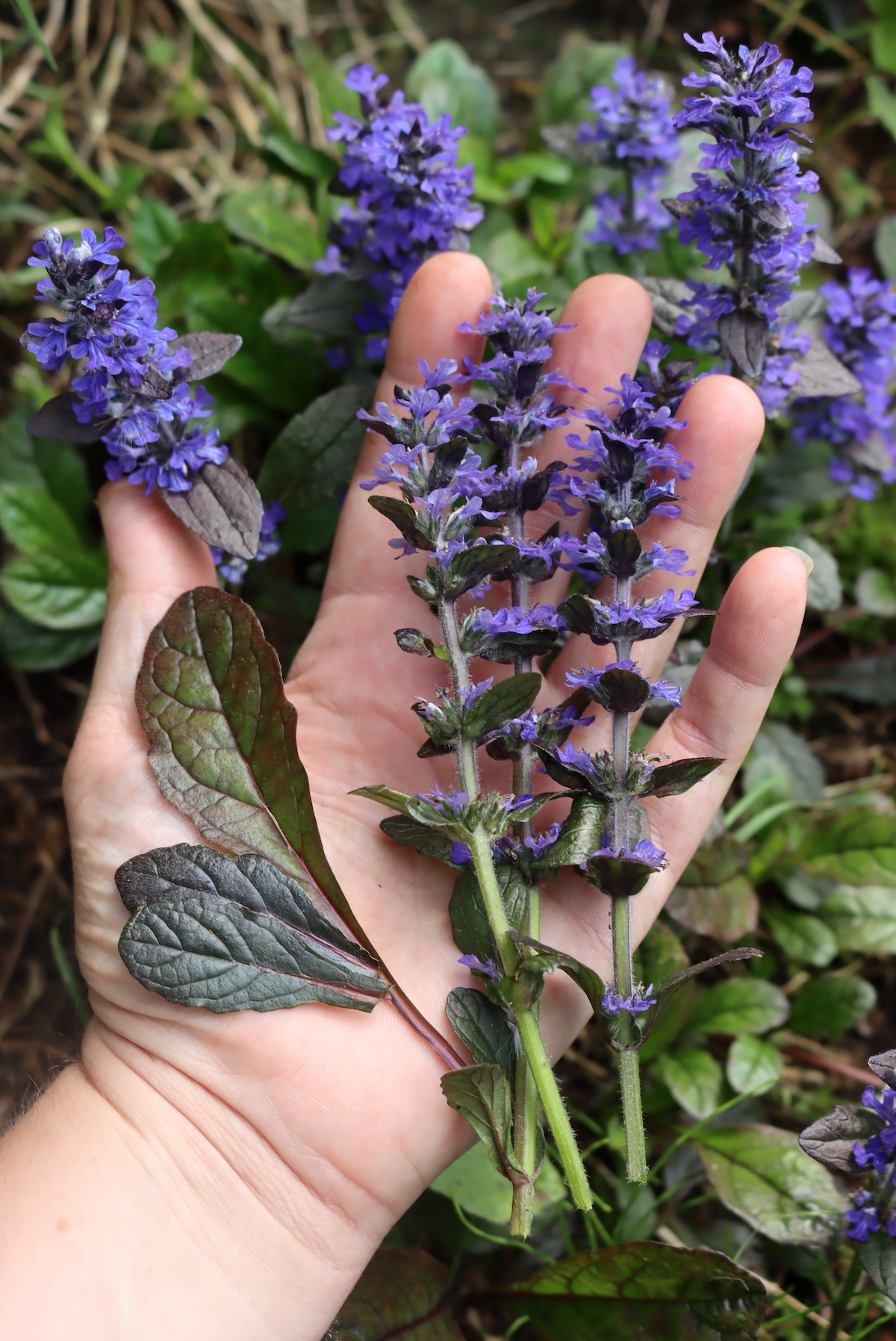
Bugleweed Stems
As with other members of the mint family, Bugleweed has square flower stems, which may grow 4 to 14 inches tall. Their color may vary from yellowish-green to green or purplish.
Bugleweed also sends out stolons. These stolons have leaves in opposite pairs and root at nodes to create new plants.
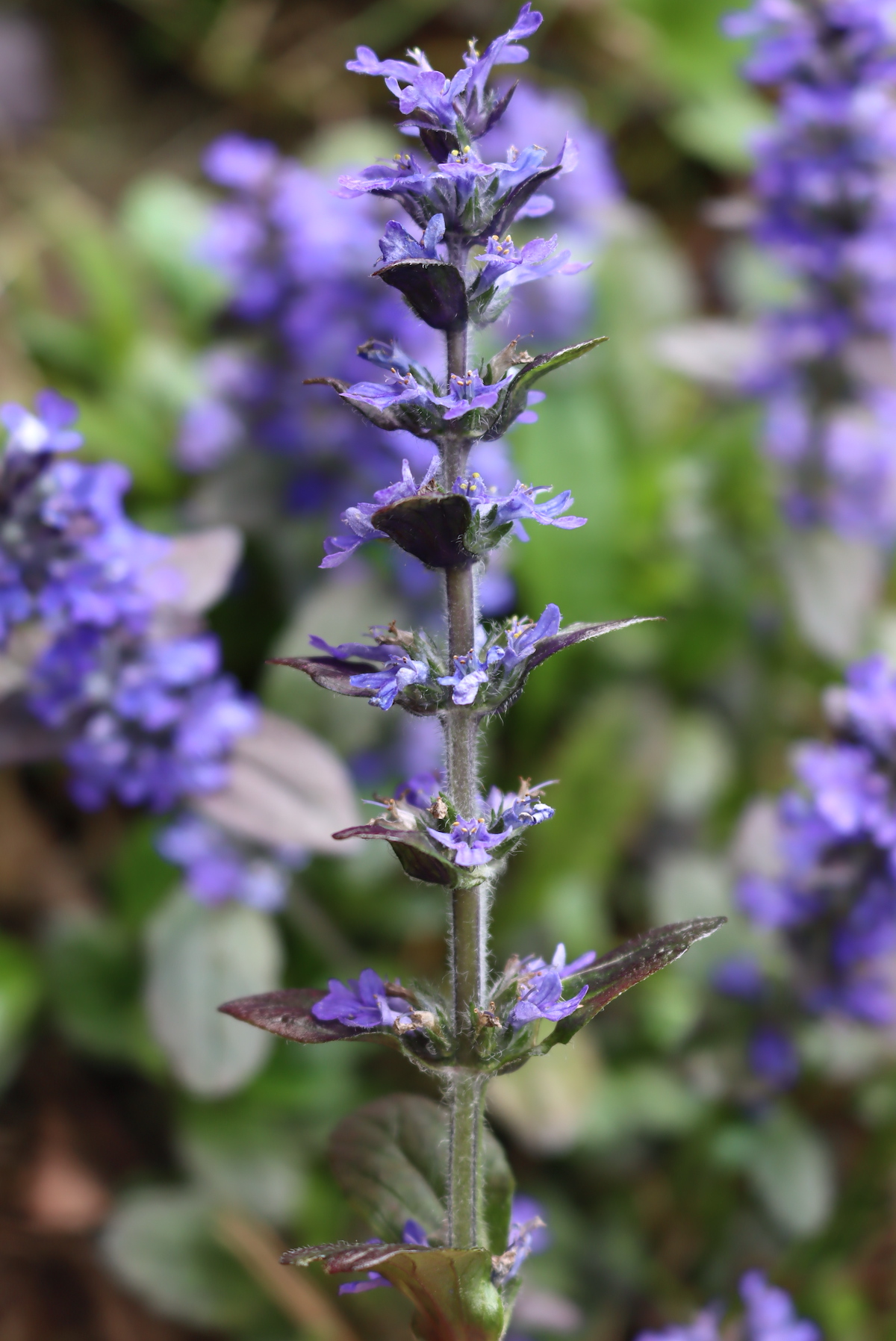
Bugleweed Leaves
Bugleweed has shiny dark green leaves with purple highlights that grow 4 to 8 inches in length. The leaves are elliptical to ovate with rounded tips and shallow, rounded teeth along the margins.
They form a basal rosette at the base of the plant and are in opposite pairs on the flower stem and stolons. Cultivated varieties may feature more varied foliage.
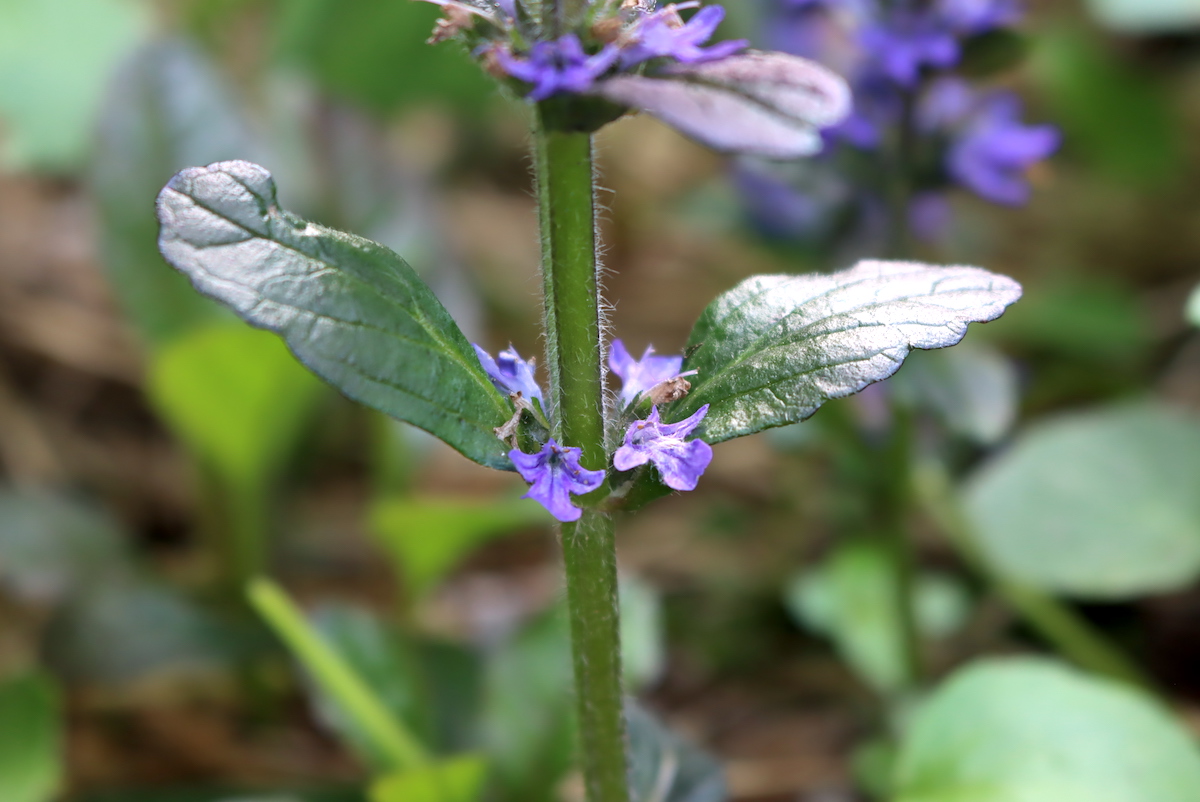
Bugleweed Flowers
Bugleweed flowers in mid to late spring, producing whorls of tiny, blue-violet flowers on stems 4 to 14 inches above the foliage.
The flowers feature bilateral symmetry and have five-toothed lobes with dark veins on the lower lip. They have four stamens.
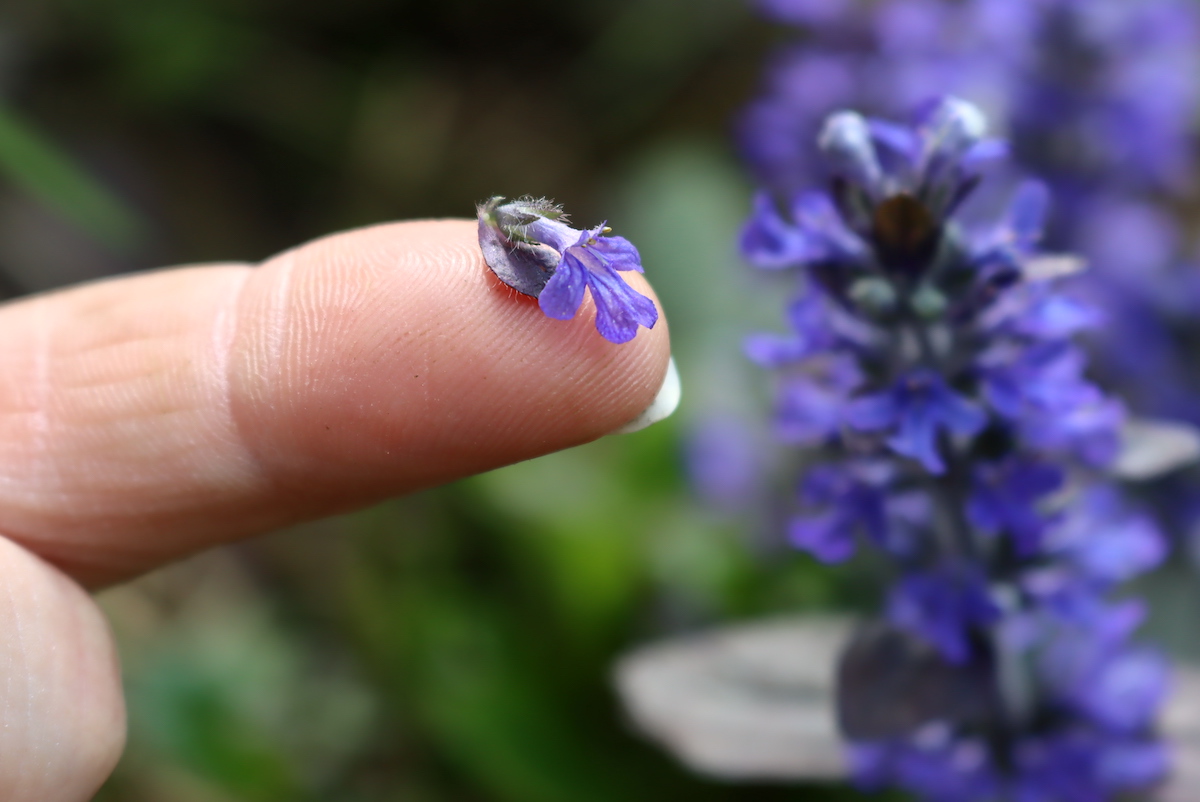
Bugleweed Look-Alikes
Bugleweed is sometimes mistaken for other members of the mint family, including Purple Dead Nettle (Lamium purpureum), Hummingbird Mint (Agastache sp.), and Catmint (Nepeta sp.). Thankfully, there are a few simple ways to tell them apart.
Purple Dead Nettle (Lamium purpureum) differs from Bugleweed in several noticeable ways:
- Purple Dead Nettle has small, fuzzy leaves, while Bugleweed leaves are larger, smooth, and shiny.
- Purple Dead Nettle’s leaves transition from green to purple-red or pinkish near the top of the stem.
- Purple Dead Nettles leaves are attached to the stem with petioles, while Bugleweed leaves are directly attached.
Some varieties of Hummingbird Mint (Agastache sp.) have purple flowers and can be confused with Bugleweed. Fortunately, it too differs in a few easy-to-spot ways:
- Hummingbird mint leaves are attached to the stem by a petiole rather than being directly attached like Bugleweed leaves.
- Hummingbird mint leaves have pointed ends rather than rounded ends.
Catmint (Nepeta sp.) can be mistaken for Bugleweed at first glance but can is distinguished in the following ways:
- Catmint leaves are fuzzy rather than smooth and shiny and often appear silver or gray-green.
- Catmint leaves have sharp, serrated teeth on the margins rather than smooth rounded teeth.
- Catmint has downy stems that also have a silver or gray-green appearance.
Ways to Use Bugleweed
Bugleweed is edible, but it’s generally only consumed in small quantities because it can be bitter. It’s best to use the vibrant purple leaves in salads where it’ll add flavor and color, but it won’t be the bulk of the greens.
Avoid older leaves raw as they’re tough, but young leaves and shoots can be used raw for salads. You can add older leaves to cooked dishes like soups, stir-fries, and casseroles.
Bugleweed Medicinal Preparations
As an herbal remedy, Bugleweed can be taken internally as tea or tincture. Bugleweed tincture is often recommended by herbalists as a natural treatment for hyperthyroidism and other hormonal imbalances.
To make a Bugleweed tincture, use the same process you’d use to make any herbal tincture. It can also be made into an alcohol free glycerite.
For tea, all you need is hot water and some bugleweed. It can be fresh or dried. You’ll want to add honey or sugar as it’s bitter.
Externally, it can be used as a poultice, herbal salve or herbal infused oil for treating wounds and stopping bleeding.
Edible Wild Weeds
Looking for other edible wild weeds?
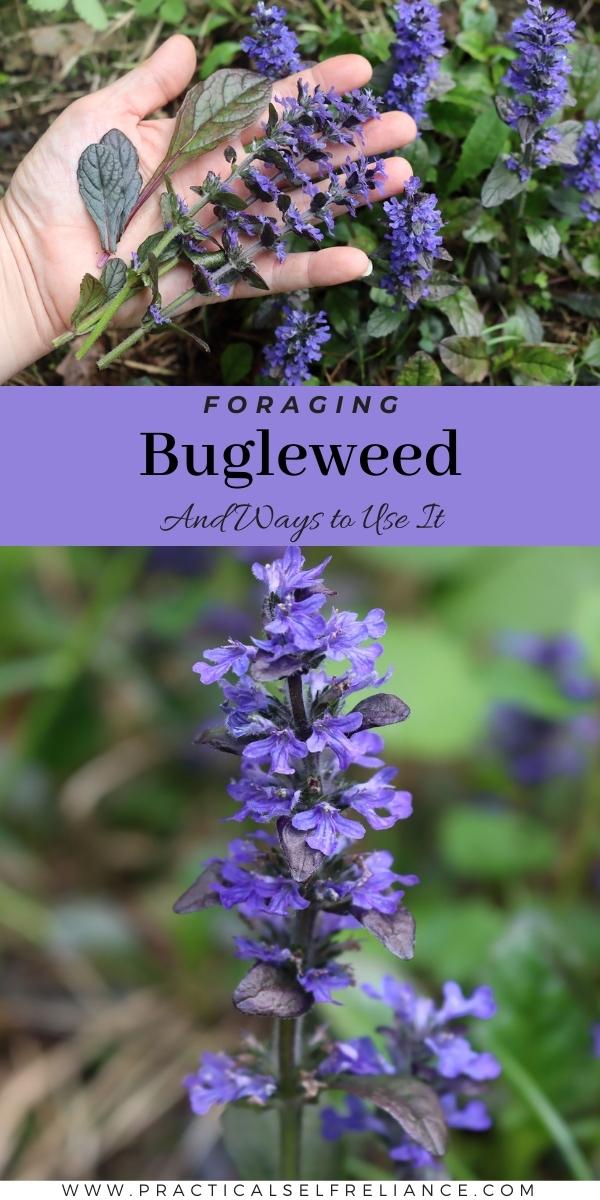

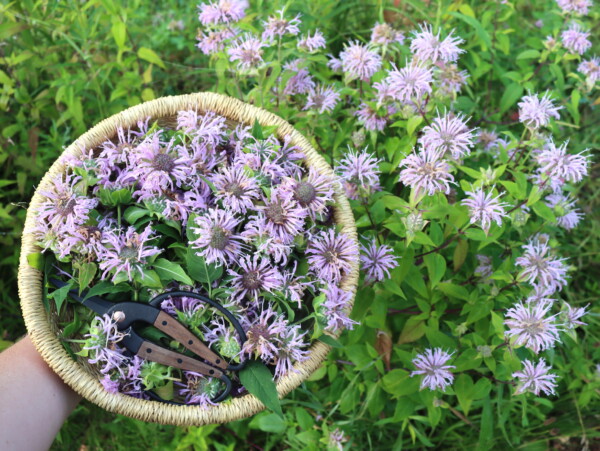
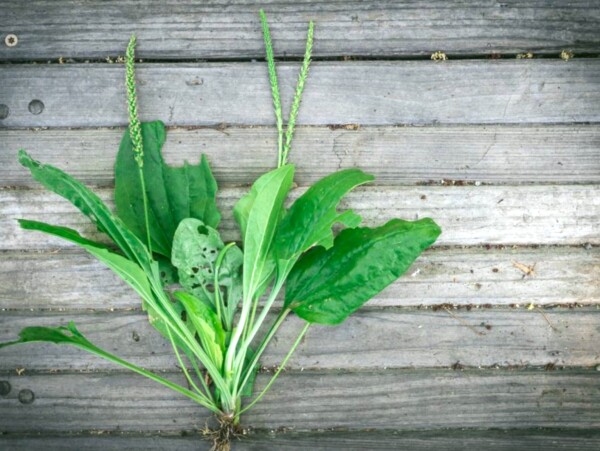
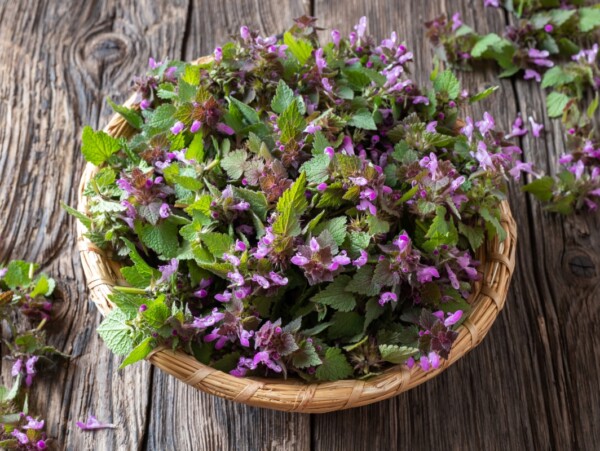










Hi ashley . I took a course on herbs at the adirondack folk school and have been hooked ever since.i cannot tell you how valuable your posts ,and website has been to me.just wanted to say thank you for sharing your incredible knowledge with us novices. Have an awesome day
Thank you so much Janine! I’m so glad it’s helpful to you =)